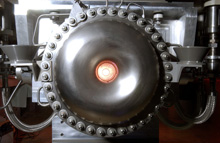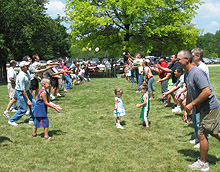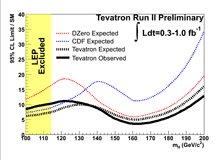 | Thursday, August 3, 2006 |
|
Thursday, August 3
2:30 p.m. Theoretical Physics Seminar - 1 West Speaker: E. Couce, Universidad de Valencia Title: Neutrino Oscillation Physics with a Beta Beam 3:30 p.m. DIRECTOR'S COFFEE BREAK - 2nd Flr X-Over THERE WILL BE NO ACCELERATOR PHYSICS AND TECHNOLOGY SEMINAR TODAY
Friday, August 4 Click here for a full calendar with links to additional information. |
|
Extended Forecast |
Secon Level 3 |
|
Thursday, August 4 -Tomato Florentine -Grilled Chicken Cordon Bleu Sandwich -Chimichangas -Chicken Marsala -Smoked Turkey Melt -Assorted Slice Pizza -SW Chicken Salad with Roasted Corn Salsa |
|
Thursday, August 3 Dinner -Salad of Field Greens, Pears and Blue Cheese w/Mustard Tarragon Vinaigrette -Fillet of Beef w/Green Peppercorns, Horseradish and Cognac Sauce -Vegetables of the Season -Chocolate Souffle w/Frangelico Cream
Wednesday, August 9
Chez Leon Menu |
| Fermilab Today is online at: http://www.fnal.gov/today/ Send comments and suggestions to today@fnal.gov Fermilab Today archive Hurricane Relief Page Fermilab Today PDF Version Fermilab Result of the Week archive Fermilab Safety Tip of the Week archive Linear Collider News archive Fermilab Today classifieds Subscribe/Unsubscribe to |
|
|
|
A phishing email that appears to come
from the Argonne Credit Union has been circulating. Do not click on the link: the intent of
this message is to steal your personal information about your Argonne
account. Several people at the lab have gone to this site and entered
information. Within an hour after an employee entered their information yesterday, someone in Romania took $400 from their account. We are working with the Argonne Credit Union to keep them
apprised of the accounts we know were compromised.
If you went to this site and entered any information, including your
login and password, contact the Argonne Credit Union by telephone
immediately and report it to them. |
| ||||
|
After nearly a month with repair crews working 20-hour days, improvising strategies like a line-up of off-the-shelf industrial-strength shop-vacs to remove water and clear the cooling nozzles, the NuMI focusing horn is back in operation and delivering neutrinos to the MINOS experiment when proton beam from the Main Injector is available. "We believe it's now essentially clear, and it appears to be running fine," said Accelerator Division engineer Kris Anderson, who directed the effort. "It takes well over a year to build one, and I'm glad we were able to fix it without breaking it."
The NuMI horn focuses short-lived particles called pions, which are generated when protons hit a target and decay to neutrinos (among other particles). The focusing is achieved using intense magnetic fields generated by 200,000-ampere pulses of electric current. In addition to neutrinos, the particles and electric current deliver enormous amounts of heat. Without 36 gallons per minute of low-conductivity (or de-ionized) water for cooling, the horn would burn itself up. At 4:40 p.m. on Friday, June 30, with one foot out the door before the extended July 4 holiday weekend, Anderson heard the last thing he wanted to hear just then: voices on the phone telling him there was no water flowing to the horn's cooling nozzles. Since the voices belonged to experts, Jim Hylen and Tom Kobilarcik, Anderson knew there was no room for doubt.
|
|
Beacon News Online August 2, 2006: Midnight bike ride an enlightening experience I recently wrote a story promoting the third annual Chase the Moon late-night bike ride. And after interviewing the event's founder, Pam Bellm, I was willing to give it a try. This was the third annual Chase the Moon ride, and Bellm promised a wacky good time. She told me not to worry about staying up late and trying to ride a bicycle in the dark. She promised hot coffee and an atmosphere filled with the energy of a happy crowd.
I enlisted my oldest daughter to ride with me. At the nocturnal age of 15, I knew she'd have no trouble staying awake, and - more importantly - keeping me awake. I have a hard time staying up past 9 o'clock on most nights.
|
| CDF and DZero: Working together to find the Higgs | ||
| ||
|
Despite its success as a predictive tool, the Standard-Model (SM) of particle physics remains incomplete without a means to explain
electroweak-symmetry breaking. The simplest proposed mechanism results in a particle (the Higgs boson) that has yet to be observed. Direct searches in e+e->Z*->ZH at the Large Electron Positron (LEP) collider yielded lower mass limits at mH>114.4 GeV/c2. Now that the two Tevatron collider experiments are analyzing their first inverse femtobarn of data, a combined CDF/DZero Higgs boson search has become a reality.
To evaluate a combined limit, the two experiments contributed a total of sixteen individual analyses. These searches were performed in the associated Higgs (pp->W/ZH) and gluon-gluon fusion (pp->H->WW) production channels, analyzing integrated luminosities in the range 0.3-1.0 fb-1. Using two different statistical methods (Bayesian and CLs), limits were calculated by both experiments to guard against any bias in the statistical treatment. The limits are derived at a confidence level (CL) of 95 percent. To facilitate model transparency and to accommodate analyses with different degrees of sensitivity, the results are presented in terms of the ratio of limits set to the SM cross sections (sigma x BR(H->X)) as a function of Higgs mass. The SM prediction for Higgs boson production would therefore be considered excluded at 95 percent CL when this limit ratio falls below unity. The observed and expected limit ratios are shown in the figure, with observed(expected) values of 10.4(7.6) at mH=115 GeV/c2 and 3.8(5.0) at mH=160 GeV/c2. These combined results represent an improvement in sensitivity over those obtained by each experiment alone. With improvements expected in the analyses, along with additional data being prepared for analysis, these encouraging results will improve significantly in the near future. | ||
| Result of the Week Archive
|
|
July 31 - August 2 - Two stores provided 31 hours and 54 minutes of luminosity - H- source failing - Pbar problems continue - High temperatures causing problems
Read the Current Accelerator Update
|
|
Helping Small Groups Make a Big Splash on the Grid
| ||
|
For three years, the Distributed Organization for Scientific and Academic Research has been helping high-energy physicists with modest computing resources make big contributions to their collaborations using the grid. DOSAR brings researchers together to share information and experiences, with the goal of accelerating the adoption of new technologies by all members.
Initially called D0SAR, for the DZero Southern Analysis Region, the group comprised high-energy research groups from six universities in the southern United States and the Tata Institute in India. The organization banded together to simulate particle physics events for the DZero experiment at Fermilab in Illinois.
|
|
Memorial Service for Jane Wilson There will be a memorial service for Jane Wilson on Sunday, August 20 at 12:00pm in the Users' Center in the Fermilab Village. If you'd like to attend, please click here.
GSA triathlon Saturday
Prairie Quadrat Program |



